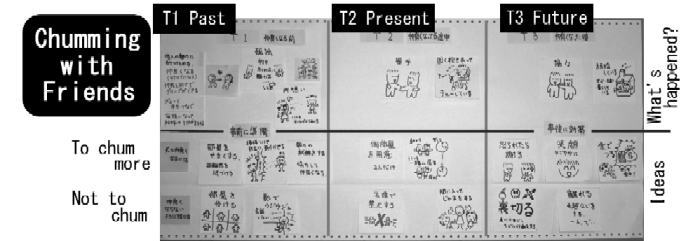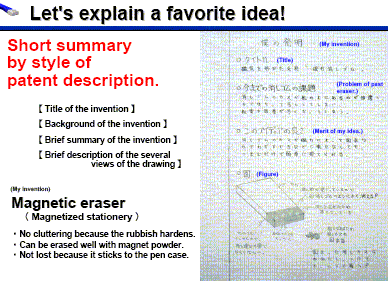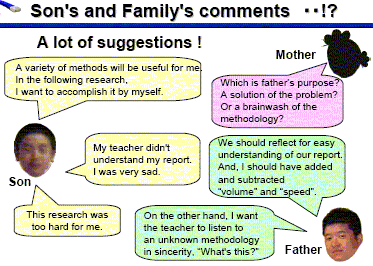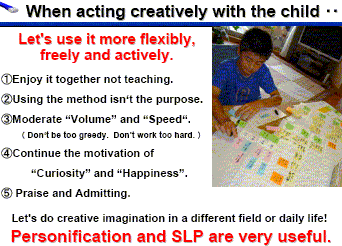A Summer Homework by Son and Father with TRIZ (2nd Time)
[Presenter:] Katsuya Miyanishi ( /Father)
Held by Japan TRIZ Society on Sept. 9-11, 2010 at Kanagawa Institute of Technology, Atsugi, Kanagawa, Japan
| Let's think in Little People’s and Person's Worlds! A Summer Homework by Son and Father with TRIZ (2nd Time) |
|
| Kai Miyanishi (2nd Grader, Kenroku Junior High School /Son) [Presenter:] Katsuya Miyanishi ( /Father) |
|
| The Sixth TRIZ Symposium in Japan, Held by Japan TRIZ Society on Sept. 9-11, 2010 at Kanagawa Institute of Technology, Atsugi, Kanagawa, Japan |
|
| Introduction (from "Personal Report of Japan TRIZ Symosium 2010" ) by Toru Nakagawa (OGU), Apr. 2, 2011 | |
| Posted: Sept. 25, 2010 |
For going back to Japanese pages, press buttons.
Editor's Note (Toru Nakagawa, Sept. 21, 2011)
This paper was presented by Katsuya Miyanishi in an Oral session of the 6th TRIZ Symposium in Japan, 2010
. As a result of participants voting, this paper obtained an "Award of Best Papers for Me", and its presentation slides have been posted publicly in the Official Site of Japan TRIZ Society since last December

.
For wider circulation of TRIZ papers, I have selected about half of the papers presented at the Japan TRIZ Symposium 2010 and am posting them in this Web site both in English and in Japanese, under the permission of the authors. Nakagawa's introduction/review to each paper was written and posted in "Personal Report of Japan TRIZ Symosium 2010" from November 2010 to April 2011, and is reposted in each page of the paper.
The present page is composed of the followings:
English page (the present page) Japanese page Abstract (in HTML) (in PDF )
Extended Absract (in HTML) (in PDF
)
Presentation slides in PDF (in this Web site)
Presentation slides in PDF (Link to the Official Site of Japan TRIZ Society)
Presentation slides in PDF (in this Web site)
Presentation slides in PDF (Link to the Official Site of Japan TRIZ Society)Nakagawa's Introduction (Excerpt of "Personal Report") -- This presentation is Miyanishi Family's 2nd report, done by Kai (13 years old) with the guidance by his Father. They try to understand how a screw nail is magnetized with a magnet, in the words familiar for the son; thus they used the personalization, or animation. Human relationships, such as getting good friends with or giving an influence on other, are considered as the hints for designing physical experiments.
[1] Abstract
Let's think in Little People’s and Person's Worlds!
A Summer Homework by Son and Father with TRIZ (2nd Time)Kai Miyanishi (2nd Grader, Kenroku Junior High School /Son)
[Presenter:] Katsuya Miyanishi ( /Father)The 6th Japan TRIZ Symposium 2010
Held by Japan TRIZ Society on Sept. 9-11, 2010
at Kanagawa Institute of Technology, Atsugi, Kanagawa, JapanAbstract
”One day, a screw that stuck to a magnet was magnetized. Why? Can I make a permanent magnet?”
The youngest son, who had seen the eldest son's research on water strider, also wanted to try TRIZ. We will report our process of the 2nd research worked together especially with the guidance of TRIZ-thinking by father.The purpose of the present study is obtaining of deep understanding of the principle and a certain experimental methodology. It is achieved by analyzing a technical problem "Magnetization of Metal" in detail by obtaining the hint from the experience of daily life, and producing the experimental methodology. Moreover, we challenged the idea-making of an original merchandise this time.
As special mention, we also used some techniques this time not used in the research of the water strider. Conception method by "SLP (Smart Little People) and personification", Analysis method by "T1:T2:T3 (Analysis at time-domain)", "Attribute Listing" and "Substance-Field Analysis", et al. were used this time. We recognized that the hint to solutions for technical problem existed in usual life and our experience.
And, when creatively acting with the child, we strongly appeal that the following matters are important. 1: Enjoy it together, not teaching. 2: Using methods isn't the purpose. 3: Moderate "Volume" and "Speed" 4: Continue the motivation of "Curiosity and happiness" by "Praise and Admitting".

Extended Abstract
1. Points of approach
1) Discovery of Experiment Parameter through the personification and various analysis methods
(1) Let's think in Little People’s and Person's Worlds!
We paraphrase "Magnetization" to a simple word, and associate "Events in Little People’s and Person's Worlds", then chose four scenes.
Scene deployment according to the passage of time, "T1:T2:T3" (Past, Present and Future) were used with "Punch Picture".(2) Return to the Magnetic World!
The solution is returned to that in the world of the magnet, classified by three aspects (S1: Magnet, S2: Screw, F: Gap) and subdivided by "Affinity Diagramming".
We chose the classification group name as "Physics parameter" used in the experiment.(3) Think about the Influence that each Physics Parameter gives to magnetic!
We thought about changing-pattern of physics parameter for "Magnetized / Non-magnetized".
And, we decided the experimental methodology, the condition (parameter combination), and the criterion.
2) Confirm by Experiments 3) Create Original Ideas (1) Think by Noun, Adjective, and Verb! We re-analyzed the feature of the magnet by using "Attribute Listing" (noun, adjective, and verb). We considered ideas that used this feature. (2)Describe Best Idea in the picture! 2. At the end We appeal the following important matters. 1: Enjoy it together, not teaching. |
 |
Extended Abstract, PDF in English
in Japanese
[2] Presentation Slides in PDF
Presentation Slides in English in PDF (27 slides, 10.9 MB)
(to JTS site)
Presentation Slides in Japanese in PDF (27 slides, 7.4 MB)
(to JTS site)
[3] Introduction by Nakagawa:
Excerpt from:
Personal Report of
The Sixth TRIZ Symposium in Japan, 2010
Part F. Usage of TRIZ in Education and in Academia
Toru Nakagawa (Osaka Gakuin University)
Mar. 18, 2011 (Posted on Apr. 2, 2011)
Kai Miyanishi (2nd Grader, Kenroku Junior High School, Kanazawa/Son), Katsuya Miyanishi (- /Father) [J03, O-7] gave an interesting Oral presentation with the title of "Let's think in Little People’s and Person's Worlds! – A Summer Homework by Son and Father with TRIZ (2nd Time)". This is the second report of 'Summer Home Work by Son and Father with TRIZ' by the Miyanishi Family living in Kanazawa. Their first report was given by Taichiro and Father on 'Why Water Striders can stand and slide on the Water?' at Japan TRIZ Symposium 2008
, and it obtained the Award by the participants voting. The second report was made here by the younger son, Kai, who was a first grader, at the time of his homework, of a junior high school in Kanazawa. Katsuya, Father, guided his son with a unique approach based on TRIZ in a flexible manner. Let's read the Authors' Abstract first:
”One day, a screw that stuck to a magnet was magnetized. Why? Can I make a permanent magnet?”
The youngest son, who had seen the eldest son's research on water strider, also wanted to try TRIZ. We will report our process of the 2nd research worked together especially with the guidance of TRIZ-thinking by father. The purpose of the present study is obtaining of deep understanding of the principle and a certain experimental methodology. It is achieved by analyzing a technical problem "Magnetization of Metal" in detail by obtaining the hint from the experience of daily life, and producing the experimental methodology. Moreover, we challenged the idea-making of an original merchandise this time.As special mention, we also used some techniques this time not used in the research of the water strider. Conception method by "SLP (Smart Little People) and personification", Analysis method by "T1:T2:T3 (Analysis at time-domain)", "Attribute Listing" and "Substance-Field Analysis", et al. were used this time. We recognized that the hint to solutions for technical problem existed in usual life and our experience. And, when creatively acting with the child, we strongly appeal that the following matters are important. 1: Enjoy it together, not teaching. 2: Using methods isn't the purpose. 3: Moderate "Volume" and "Speed" 4: Continue the motivation of "Curiosity and happiness" by "Praise and Admitting".
The slide (below-left) shows the beginning of their work. Kai wanted to do his summer homework with his father, just like his elder brother Taichiro had done 2 years before. Kai brought in the topic, saying "I saw that after attaching a screw to a magnet for a long time, the screw obtained the power of magnet to attract other screws. I want to learn how the screw is made into a magnet." And Father thought the topic interesting, and said "Let's learn about it together." Thus the purpose of the homework was set, as shown in the slide (below-right). "What is necessary to make a screw into a magnet? Let's guess the conditions and carry out experiments for confirmation."


Father of course knew the physical micro-structure of magnet and the mechanism of magnetization, but he wanted to make the phenomenon of magnetization understandable for a boy of 12 years without using the concepts in physics. [*** This is the point very unique in this work guided by Katsuya Miyanishi.] The slide (right) explains the basic approach. The magnetization phenomenon in physics is paraphrased (in an abstract world) into the phenomena of human relations for understanding the meaning (even for a child). Thus they consulted a dictionary about the word of Magnetization, and found "It is a phenomenon that a material becomes to hold magnetism when a magnetic field is applied to the material from outside." In a word, "it occurs by the influence from outside." At this level of abstraction, children can think of various cases where something similar occurs as the results of influence from outside. The world of human relationships is easier for them to think of such effects of influences. |
 |
The slide (below-left) shows the overall structure of their approach. In the first stage (T1) they think of various cases of 'becoming similar by the influence from outside' in the world of human relationships. This stage is explained in more detail in the slide (below-right). The technical (or physical) problem is abstracted into the problem (or event) in the world of human relationships, where either ordinary people or imaginary Smart Little People are observed. In such an abstract world, the Authors try to think of various ways (i.e., solutions) to enhance the influence and also to reduce/prevent the influence. Then they return to the real world of making magnets, and try to extract the conditions for doing experiments for verification. They did the experiments in the second stage (T2, in the slide (below-left)), and tried to apply their ideas in the third stage (T3).


In the slide (right), the Authors thought of various scenes where a person (or an SLP) can give influences on others to make them become similar (or behave similarly). Among the 9 scenes illustrated in the slide, they have selected the following 4 scenes: (1) Chumming up with friends, (2) Influence of timidity (i.e.,when one is afraid of something, others also become afraid of it.), (3) Feel cold in the shower of water, (4) Infection of influenza (catching cold).
|
 |
Then the Authors tried to imagine the scenes more vividly in the world of human behaviors. The slide (right) handles with the first case of making good friends. Various human behaviors are illustrated in slips and are classified into three timings; i.e. Past (T1, before chumming), Present (T2, at the time of chumming), and Future (T3, after chumming). Then they thought of various means to increase/decrease the degree; i.e. to become friends more/less smoothly. Each idea of means is written in a slip of paper by using keywords and an illustration.
|
 |
In the same framework other three scenes were also considered, as shown in the slide (right).
|
 |
The means imagined in the four different scenes were collected together, as shown in the slide (right). The upper part shows the means (or solution ideas) to increase the degree of smooth influencing, even though the contents of the influence are different in the four scenes. For example, at the preparatory stage (T1), there are various ideas, e.g. 'The room is made small' (for becoming good friends), 'Gather timid fellows' (for making them more timid), 'Become naked before the shower' (for feeling cold in the shower), 'Visit disease zone' (for being infected with influenza), etc. At the bottom part, ideas for decreasing the influences are collected.
|
 |
At the next stage, returning to the physical world of magnets, the ideas which were expressed in the world of human behavior were interpreted in the words of matters. For example, 'Always together' (for chumming) is interpreted as 'Joint them for a long time' (for magnetizing); 'Grumble loudly' (for influencing timidity) is 'Make use of stronger magnet' (for magnetizing), 'Pre-cooling' (for feeling cold in shower) is 'Adjust the temperature beforehand' (for magnetizing), etc. Then all the ideas expressed by the keywords in the world of magnet were classified by using the Affinity Diagram Method (Slide (bellow-right)). The group names in the Affinity Diagram are interpreted as (or related to) the experimental parameters, e.g., location, distance, temperature, obstacles, etc.


Then the Authors designed physical experiments for examining/confirming their various ideas derived so far by the analogical thinking in the human behavior. Slide (below) summarizes their experiments. They chose to vary the following factors in the magnetization process: Time length (3 days / 1 week), Strength of the magnet (600 / 2000 Gauss), Temperature (30 / -18 C), Obstacle (with / without an iron board). And then they tested how strong the magnetized screw could attract/hold up small iron objects like a clip or a stapler needle. The photos show the actual way of their experiments. In the photo (bottom-left), each screw is placed up right on a small magnetic disk. The results of the experiments are shown in the table. The Authors say it was hard to find clear difference in the results. But the results hand-written in the slide say: (1) Attract the more by magnetizing with the stronger magnet. (2) Lower surrounding temperature is better. (3) Stronger with the iron plate in the middle than without it.

As an application of the findings obtained during the study, a favorite idea was written down in the form of a patent description (slide(right)). Kai's invention is a magnetized eraser (i.e. an eraser containing magnetized iron powder) which may be good in erasing and have the merit that the waste debris of the eraser will gather together by themselves. [*** It is nice to write down any favorite idea in this form. This is a charming idea by a boy.] |
 |
In the slide (below-left) the Authors summarize their study. Unique point of the Authors' approach is trying to understand the technical problem or physical phenomenon more deeply by using the hints in a field quite different but familiar for children, i.e. the field of human relationships and daily life. Comments by the family members are shown in the slide (below-right). Kai, the Son, feels that a variety of methods he used here will be useful later in his way of thinking and that the present work was too hard for him. The Authors reported that when Kai showed the homework report to his teacher in the beginning of September the teacher could not understand the work and was not interested in it at all. Kai was disappointed much with the fact. Katsuya, Father, reflected on the hardness of the work, in the aspects of its understandability, volume, and speed. He wants the teacher to be more curious to listen to an unfamiliar method like this.


In the last slide (right) the Author, Katsuya, summarizes the lessons learnt from the present activity with his boy. [*** All these points are very interesting and important, I feel.] He says at the top "Let's use it more flexibly, freely, and actively". [*** He uses various methods of TRIZ but in a unique way after reorganizing for the present case.] This point is directly connected to the point (2) "Using the method isn't the purpose." Most important point is (1) "Enjoy it together, not teaching." Thus we should try to (4) "Continue the motivation of Curiosity and Happiness" by (5) "Praising and Admitting" and by (3) "Moderating the Volume and Speed". [*** All these are important lessons we should keep in mind in various activities with children.] At the bottom of the slide the Author writes "Personification and SLP are very useful." [*** This is the most unique point of this presentation. Instead of trying to 'teach' the physical phenomenon in terms of physics, the Author tried to enjoy understanding it in the words of daily life and human behavior, which children can imagine and understand well. ] |
 |
[*** This presentation is not an orthodox way of TRIZ application. But we can learn a lot from this. This presentation obtained the Award of "Best Presentation for Me" by the participants voting of the Symposium. Congratulations Kai and Miyanishi Family to your wonderful homework report! ]
| Top of this page | Abstract | Presentation Slides in PDF |
Presentation slides in Japanese |
Nakagawa's Introduction (Excerpt from Personal Report) | Nakagawa's Personal Report of Japan TRIZ Symp. 2010 |
Japan TRIZ Symp. 2010 |
Japanese page |
Last updated on Sept. 25, 2011. Access point: Editor: nakagawa@ogu.ac.jp